Excerpt from the Avalon Mystery School, Course III
NOTICE: THIS WORK MAY BE PROTECTED BY COPYRIGHT
YOU ARE REQUIRED TO READ THE COPYRIGHT NOTICE AT THIS LINK BEFORE YOU READ THE FOLLOWING WORK, THAT IS AVAILABLE SOLELY FOR PRIVATE STUDY, SCHOLARSHIP OR RESEARCH PURSUANT TO 17 U.S.C. SECTION 107 AND 108. IN THE EVENT THAT THE LIBRARY DETERMINES THAT UNLAWFUL COPYING OF THIS WORK HAS OCCURRED, THE LIBRARY HAS THE RIGHT TO BLOCK THE I.P. ADDRESS AT WHICH THE UNLAWFUL COPYING APPEARED TO HAVE OCCURRED. THANK YOU FOR RESPECTING THE RIGHTS OF COPYRIGHT OWNERS.
One of the most beautiful and significant symbols of the Western Mysteries is the Rose. The Rose and the Grail share many spiritual resonances. The word ‘chalice’ comes from the Latin word, calyx, which means cup, and is the name given to the cup-like sepals of a flower which support the petals. Both these symbols suggest the receptive vessel of the soul, opening to receive the in-pouring of Divine influence. Indeed the symbolism of the Rose is even more complex than the Grail, given the beauty of its form, the number and arrangement of the petals with their velvety texture, the intoxicating perfume and, deep inside, the hidden golden heart enfolded within the petals, concealing the Mystery of the Centre. A 12th century Persian poet wrote, “Mystery glows in the rose bed, the secret is hidden in the rose.” Not surprisingly, the rose has long been recognized as the western equivalent of the eastern lotus as a symbol of the unfolding of higher consciousness.
In medieval Europe, the Rose as a symbol of union with the divine may have been influenced by Arabian and Persian teachings from the time when Spain was an Islamic country. The Sufi teacher, Hazrat Inayat Khan writes:
Just as the rose consists of many petals held together, so the person who attains to the unfoldment of the soul begins to show many different qualities. The qualities emit fragrance in the form of a spiritual personality. The rose has a beautiful structure, and the personality which proves the unfoldment of the soul has also a fine structure, in manner, in dealing with others, in speech, in action. The atmosphere of a spiritual being pervades the air like the perfume of a rose.
The Goddess and the Rose
As well as being a symbol of mystical union, the Rose is particularly associated with the numinous beauty of the goddess and the love her presence evokes within the human heart. It was the most revered flower in ancient Egypt, sacred to Isis herself. Petals, whole flowers and wreaths of roses have been found heaped upon the oldest tombs in the pyramids.The famous Latin work, Metamorphoses or the Golden Ass, by Apuleius, is an allegory of the trials of an initiate, Lucius, (Light) who seeks liberation from his unfortunate transformation into a donkey. He is finally initiated by Isis himself and returned to his human shape by virtue of her roses.
Alexander the Great was said to have brought roses to the West, and they can be discovered in profusion in the mythology of classical Greece. Hecate, goddess of the crossroads and the underworld was sometimes depicted wearing on her head a garland of five-petalled roses. Roses are particularly associated with Aphrodite, the goddess of love. One legend tells that the first roses sprang from her tears while another says that it was a gift for gods to celebrate her rising from the sea. Yet another story goes that the rose was originally white, but became red when the goddess pricked her feet on the thorns as she sought her slain lover. In Rome, an effigy of the goddess Cybele, known as the Magna Mater, (Great Mother) was celebrated by being carried in procession covered with roses. A Greek legend tells that it was Cybele herself who created the rose, as she was jealous of Aphrodite and wanted to make something on earth more beautiful than her in their rivalry for Adonis. The priestess of Aphrodite wore wreaths of white roses, and the paths of her sanctuary were strewn with roses.
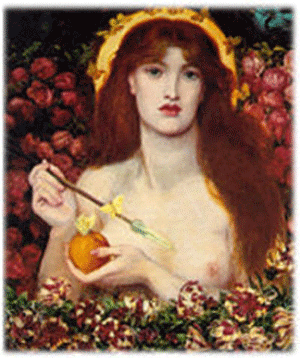
In the Roman era, Aphrodite became Venus, to whom the rose was also sacred. It was also in Rome that the ancient expression, sub rosa, ‘under the rose,’ originated, referring to the ancient custom of hanging a rose over a council table to indicate that everything spoken was to remain secret. This custom may have derived from an ancient Egypt image of Horus, the divine son of Isis, called Harpocrates by the Greeks, sitting within a rose with his finger to his lips, ordaining silence about the mysteries.
Pagan flower festivals were soundly denounced when Christianity became the official religion of the Roman Empire. The Church Fathers regarded roses as damnable, because of their association with Venus, and even banned them from graveyards. The festivals continued in Germany for a while after, with the rose-garden (or rose grove) being identified with the mountain of Venusburg, and witches came to be called “visitors of the grove.”
The Faery Rose
As the rose was sacred to the goddess, it stands to reason that it should also be sacred to the Faery Queen. Her rose is the original wild variety which had five green sepals and five petals in a circle. Her other special flowers, the apple-blossom and the hawthorn, also have five petals apiece, and belong to the same family as the Rose. As you learned in the course on Sacred Earth Magic, faeries are attracted to rose oil.
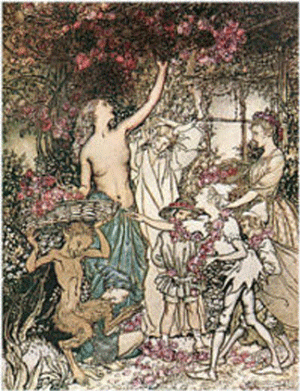
In Germany, the rose belongs to the dwarves and is under their protection. In many places it is customary to ask permission of their king before picking lest one lose a hand or foot. In the famous story of Beauty and the Beast, Beauty’s father plucks a rose for his daughter which angers the Otherworld denizen of the land.
In the Scottish ballad of Tam Lin, the heroine, Janet, plucks a ‘double rose’ at the well of Carterhaugh and attracts the attention of its Guardian, Tam Lin. Once a human knight, this young man had been held in captivity in the faery realm by its queen.
She had na pu'd a double rose,
A rose but only twa,
Till upon then started young Tam Lin,
Says, Lady, thou's pu nae mae.
Why pu's thou the rose, Janet,
And why breaks thou the wand?
Or why comes thou to Carterhaugh
Withouten my command?
Tamlin had now become the Guardian or Genus Loci of the sacred well, and was angry that his roses had been picked by an intruder. Yet, as the flower of love, the rose in this ballad is also a prelude to the coming union between Janet and Tamlin.
The Rose also appears in connection with the Underworld goddess in the German story of Tannhäuser, a 13th century minnesinger, or troubadour, whose adventures were retold in Wagner’s famous opera of the same name. Although laced with some heavy Christian moralising, the story is essentially the same as that of the Scottish legend of Thomas the Rhymer, whose meeting with the queen of Elfland and journey with her into the Eildon Hills, is one of the fundamental stories of the UnderRealm and Faery tradition, as recounted in the first course in this series. Tannhäuser is riding by the Mountain of Venus, when the goddess herself appears before him ‘as a white, glimmering figure of matchless beauty.’ The Rose of the goddess is all around her: a soft roseate light glows around her, and her handmaidens scatter roses at her feet. She leads the lovestruck minstrel into the mountain, and wherever she steps, flowers spring up to create a ‘radiant track.’ Tannhäuser follows her into her palace deep in the heart of the mountain and spends seven years there in delight and revelry, just as Thomas did with the Faery Queen.
Rosa Mystica
During the era of courtly love in 12th century France, the Rose became the chief symbol of the newly re-emerging feminine principle. It represented romantic love, and especially the beloved lady herself, in many of the poems of the troubadours. Under Christianity, the foremost personification of the Divine Feminine was, of course, the Virgin Mary, so it was perhaps inevitable that the Rose became her special flower as it had been for the goddesses of old.
Soon the mysterious rose, sacred to Venus in earlier times, became the flower of the Virgin Mary, who herself became the Rosa Mystica. The temple of Jupiter Capitolinus became St. Peter's, the temple of Juno Lucina the church of S. Maria Maggiore, and the processions honouring the Mother of God walked on rose petals, just as the processions carrying the images of the pagan gods had done.
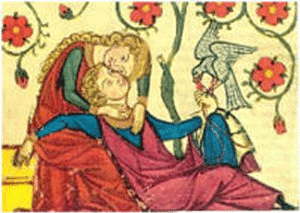
So Mary became the Mystic Rose, just as she had become an image of the Grail. One legend goes that the Archangel Gabriel wove 150 roses into three wreaths for Mary. Red roses became the symbol of Mary’s sorrows, as they had once been for Aphrodite, only now the reason given was that drops of Christ’s blood spilt upon a thornbush. White roses signified Mary’s joy, and the golden rose her glory. So similar were these devotions to the pagan goddess of old, that in 440 C.E., Isidore of Pelusium warned: “We should really be more careful in marking the difference between the heathen Magna Mater and our Magna Mater Mary.”
Mary was given many rose-names, including Rose of Sharon, the Rose-garland, the Wreath of Roses, and Queen of the Most Holy Rose-garden. The litany of Loreto called her ‘Rosa Mystica,’ the Mystic Rose. She was often addressed as the ‘Rose without a Thorn’ because she was as pure as the original rose that grew in the Garden of Eden. According to the Christian legend, the thorns came only when it was planted on earth after Adam and Eve were expelled from the garden. Mary was regarded as a ‘second Eve’ whose purity restored her to the paradise from which Eve had been driven. She was considered the perfect example of our union with God, so the Rose became a symbol of the union between Christ and Mary, as in this 15th century poem:
There is no rose of such vertu
As is the rose that bare Jesu,
Alleluia.
For in this rose conteined was
Heaven and earth in littel space,
Res miranda. . .
When the magnificent Gothic cathedrals soared above the skyline of medieval cities from the 12th century onwards, many of them displayed ‘rose windows,’ beautiful circular mandalas illuminated with richly-colored stained glass.
Most were dedicated to Mary and situated at the west end, the direction of the Feminine. Perhaps the most famous is the Rose of France window at Notre Dame de Chartres Cathedral, which was built on what was once the most important centre of the Druids in ancient Gaul. Mary is seated at the centre, holding the Christ Child, surrounded by circles of doves, angels, kings and prophets. The famous 11-circuit labyrinth below has the same dimensions as the window, which is as high up on the western wall as the labyrinth is away from it. If you could fold the wall over onto the floor, the rose window would be perfectly superimposed upon the labyrinth, the centre of which is called the rosette.
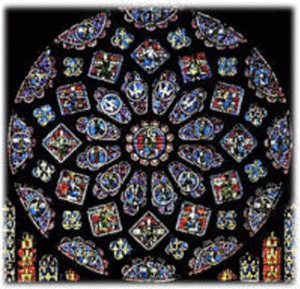
The Rose Garden
The earliest gardens of the desert lands of the Middle East were designed to emulate Eden, with four streams flowing out to the four directions, and a Tree of Life in the center. From Persia came gardens laid out like mandalas, surrounded by four walls, suggestive of seclusion and completion, with a fountain of crystal water in the centre. Tree and fountain are both feminine symbols of the creative source of life that emerges mysteriously from the unseen world that lies behind our own, continually renewing and being renewed. In fact, our word ‘Paradise’ comes from the Persian word for a garden. The medieval rose-garden was purposefully laid out in this four-square design, making it a mirror of the original primal harmony of Eden, so that by the 12th century, the rose-garden had become the standard image of paradise.
The Cistercian monks created beautiful rose gardens in the cloisters of their monasteries, and the Cistercian monk, Alanus de Insulis, described the earthly paradise as a place of the eternal spring, flaming with roses that never wither or die.
One of the greatest works of medieval literature is The Romance of the Rose, an allegory of courtly love composed by two French poets in the 13th century. It tells how a young man dreams of a beautiful rose which he desires above all else. He enters a four-square rose garden in search of the Rose that is held captive within. Some esoteric scholars believe that rather than extolling romantic love, The Romance of the Rose is a treatise on spiritual initiation, whose true purpose was deliberately concealed in allegorical images to avoid the censure of the church. A. E. Waite writes:
The Romance of the Rose is the epic of ancient France. It is a profound work in a trivial guise, as learned an exposition of the mysteries of occultism as that of Apuleius.
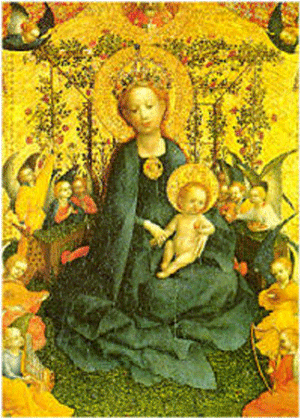
In many medieval paintings, Mary is pictured within a hortus conclusus, a walled garden filled with roses. The walled garden is womb-like, and Mary was sometimes regarded as the garden itself, the virginal matrix in which the Son of Light was conceived and brought to birth. She may be seated beneath a rose arbor or before a tapestry of roses, wreathed with a rose crown and holding a white rose. The rose takes the place of a Queen's scepter, suggesting that her power comes from divine love rather than worldly elevation. Love is the only key that can unlock the door to the garden and reveal the secret of the hidden rose.
